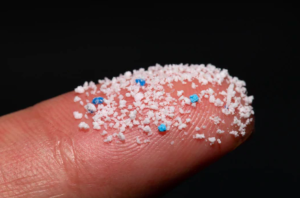
Environment
Why forensics could be key to untangling the ocean microplastics crisis
Scientist Peter Ross uses all the high-tech tools of a crime scene investigator — except his crime scene is the open ocean
- 2179 words
- 9 minutes
Environment

The environmental dangers of microplastics are becoming well known. These tiny particles — most all but invisible at less than half a millimetre across — form when larger pieces of plastic break down or are shed from water bottles, plastic packaging, or synthetic clothes, and have been found throughout the oceans, and even in Arctic ice.
When these tiny floating particles are ingested by animals, over time they can block the digestive tract and fill the stomach, causing the animals to grow more slowly, or even starve to death. Dangerous chemicals like polychlorinated biphenyls (PCBs) can also attach themselves to the plastic, causing damage to the liver and other organs.
Now, research is finding that these particles are also ending up in the food we eat, the water we drink, and even the air we breathe.
Scientists in Austria recently examined stool samples from eight healthy volunteers from Europe and Japan, looking for 10 different kinds of plastic. No sample was free of microplastics. The samples contained, on average, 20 microplastic particles per 10 grams of stool, with the most common plastics being polypropylene and polyethylene terephthalate. Some samples had as many as nine different types of plastic present.
The researchers don’t know where the plastic came from, or how it was ingested, but because there were so many different kinds, they suspect there were a variety of sources, including food packaging, seafood and salt. That idea is backed up by an earlier study by researchers at the University of Victoria, which looked at studies of plastic in various foods to estimate how much people might be consuming each year. The numbers are staggering: they estimate, conservatively, that the average person is consuming and inhaling between 70,000 and 121,000 pieces of microplastic annually.
The big question, however, is what effect this might be having on human health. So far, we don’t know, but researchers are particularly concerned about the harmful effects of chemicals used in plastics. Some are endocrine disruptors that interfere with normal hormone function, while flame retardants can interfere with brain development in fetuses. Other chemicals that cling to plastic can cause cancer or birth defects. And some of the plastic particles are small enough to enter human tissues, where they could trigger immune reactions or release toxic substances.
All the more reason to keep plastic out of our oceans, and out of our food chain.
Are you passionate about Canadian geography?
You can support Canadian Geographic in 3 ways:

Environment
Scientist Peter Ross uses all the high-tech tools of a crime scene investigator — except his crime scene is the open ocean

Environment
Doing your part as an eco-conscious consumer doesn’t end once you buy a bioplastic product

Environment
Peter Ross, vice-president of research at Ocean Wise, explains his work on marine microplastic pollution and why we all have a role to play in combating it

Environment
A team of Canadian researchers has found evidence that microplastics and microfibers have infiltrated Arctic ecosystems, but the source of these tiny fragments is still unclear